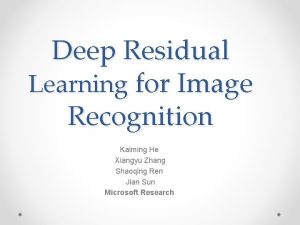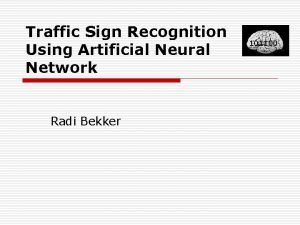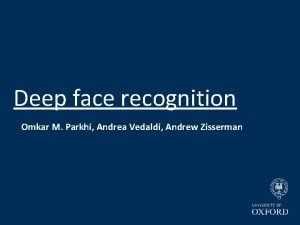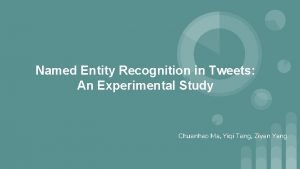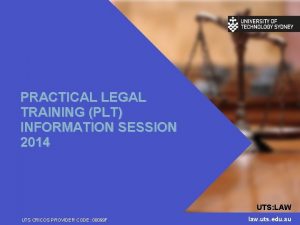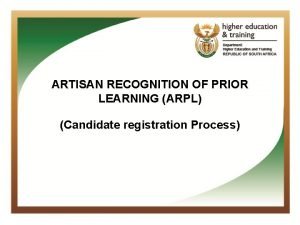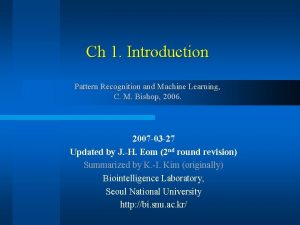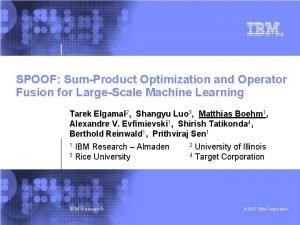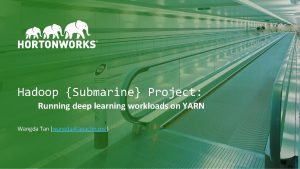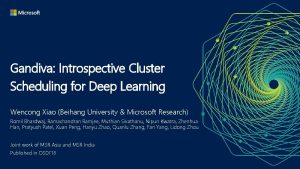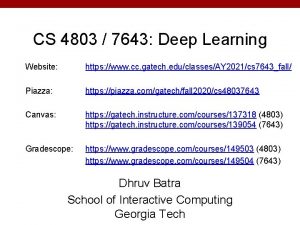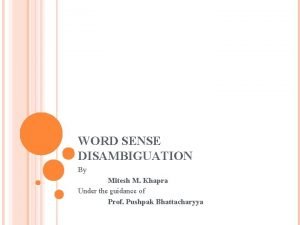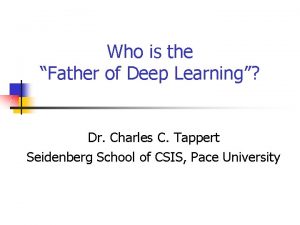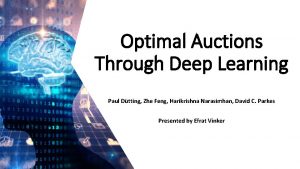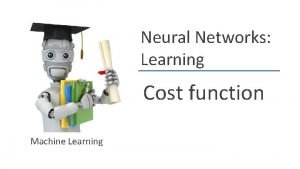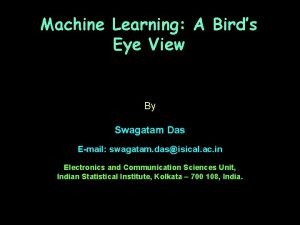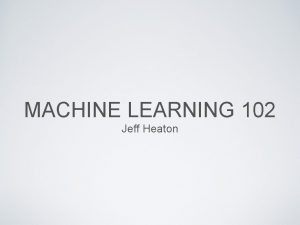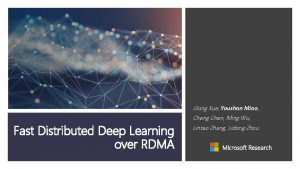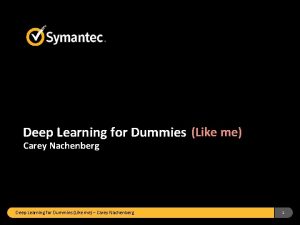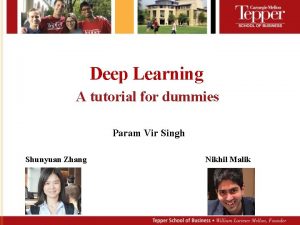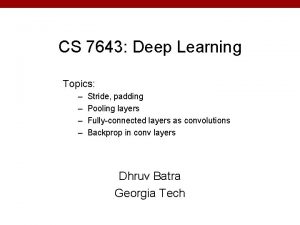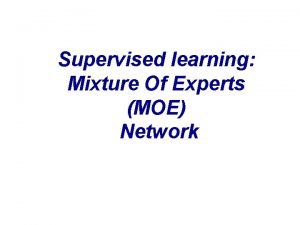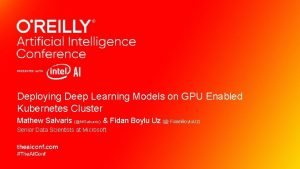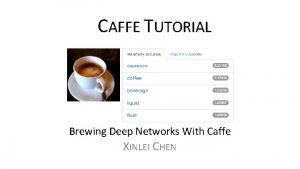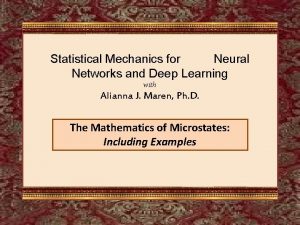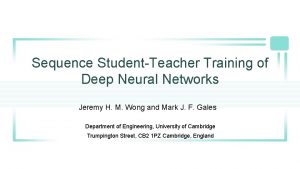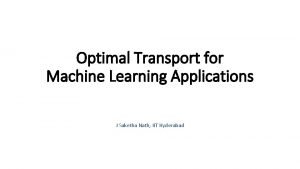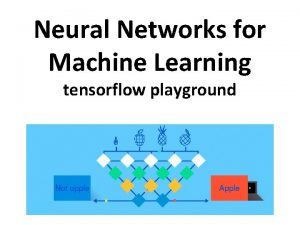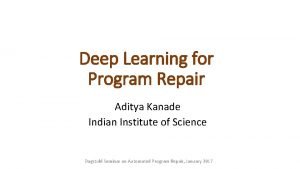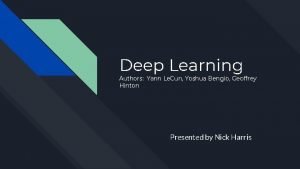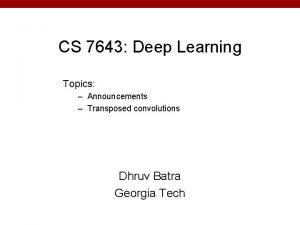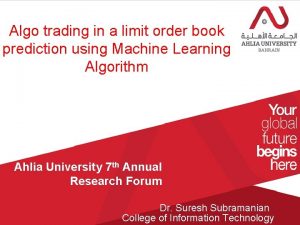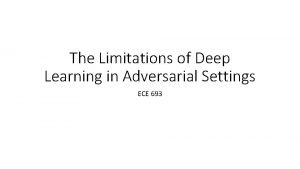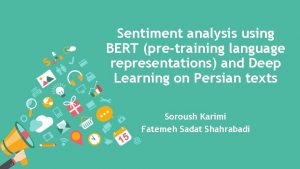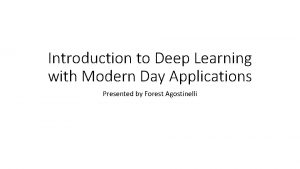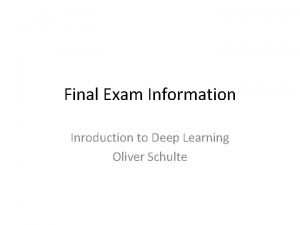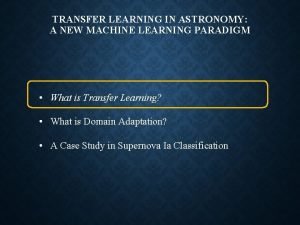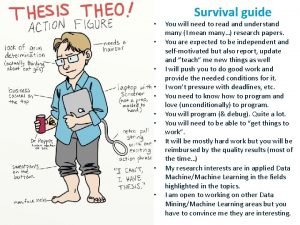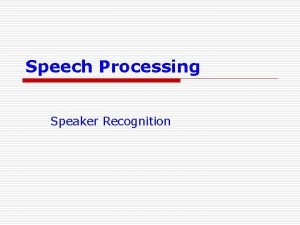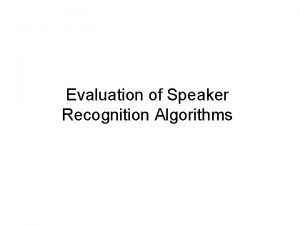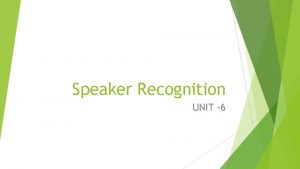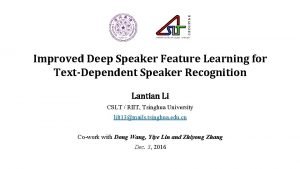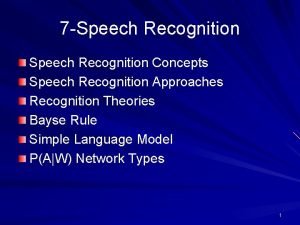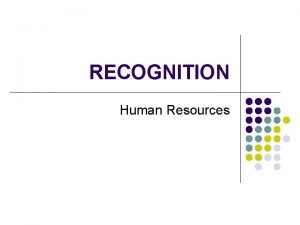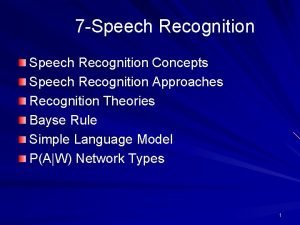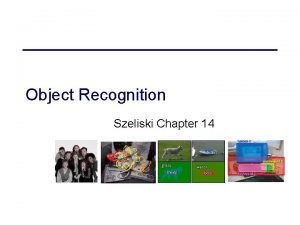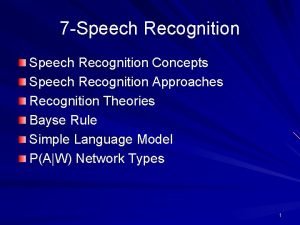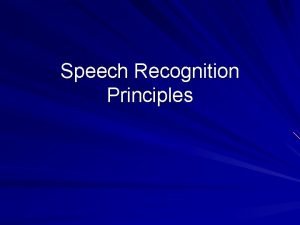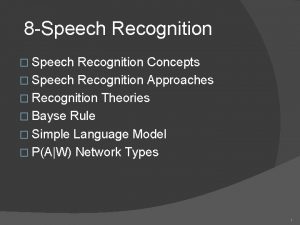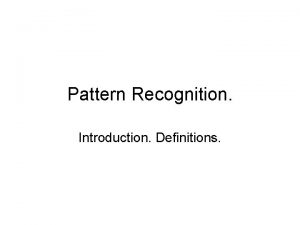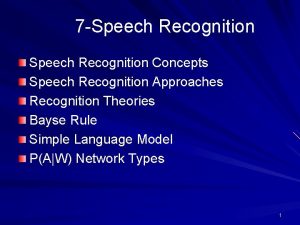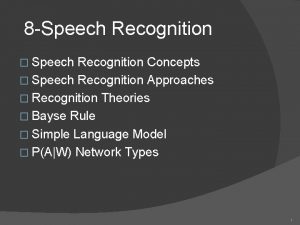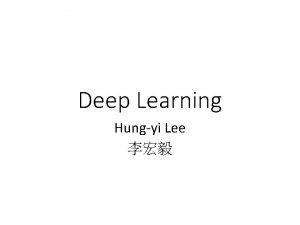Study on Deep Learning in Speaker Recognition Lantian


![Biometric recognition • Biometric refers to metrics related to human characteristics [wiki]. Term "biometrics" Biometric recognition • Biometric refers to metrics related to human characteristics [wiki]. Term "biometrics"](https://slidetodoc.com/presentation_image/286dd16d7afc8a968d9eade58b179f31/image-3.jpg)
















































- Slides: 51

Study on Deep Learning in Speaker Recognition Lantian Li CSLT / RIIT Tsinghua University lilt@cslt. riit. tsinghua. edu. cn April 24, 2017

Outline • Biometric Recognition • Speaker Recognition • Deep Learning in Speaker Recognition • Prospects
![Biometric recognition Biometric refers to metrics related to human characteristics wiki Term biometrics Biometric recognition • Biometric refers to metrics related to human characteristics [wiki]. Term "biometrics"](https://slidetodoc.com/presentation_image/286dd16d7afc8a968d9eade58b179f31/image-3.jpg)
Biometric recognition • Biometric refers to metrics related to human characteristics [wiki]. Term "biometrics" is derived from Greek words bio (life) and metric (to measure). • Biometric recognition is a kind of automated technologies for measuring and analyzing an individual's physiological or behavioral characteristics, and can be used to verify or identify an individual.

Biometric recognition £ Fingerprint £ Face Physiological Characteristic £ Palmprint £ Iris £ Retina Scan £ DNA £ Signatures Behavioral Characteristic £ Gait/gesture £ Keystroke £ Voiceprint





Face recognition

Rich information contained in speech signal Where is he/she from? What language was spoken? Accent Recognition Language Recognition Speech Recognition Emotion Recognition Gender Recognition Speaker Recognition Positive? Negative? Happy? Sad? Male or Female? Who spoke? What was spoken?

Speaker recognition • Speaker recognition is the identification of a person from characteristics of voices (voice biometrics). It is also called voiceprint recognition. [wiki]

Speaker recognition categories • Speaker Identification ² Determining which identity in a specified speaker set is speaking during a given speech segment. • Speaker Verification ² Determining whether a claimed identity is speaking during a speech segment. It is a binary decision task. • Speaker Detection ² Determining whether a specified target speaker is speaking during a given speech segment. • Speaker Tracking (Speaker Diarization = Who Spoke When) ² Performing speaker detection as a function of time, giving the timing index of the specified speaker.

Speaker recognition categories • Text-dependent • Text-independent • Text-prompted

Speaker recognition • Advantages of Speaker recognition ² Speech signal more accessible ² The use more acceptable by users ² Remote authentication more convenient • Application scenarios ² Access control (e. g. voice lock) ² Transaction authentication (e. g. remote payment) ² Forensic analysis (e. g. police criminal detection)

Speaker recognition history , tion a m for n i tor e c n e o v ph p spkdee 2010 Keep pace with times Work together to develop PLP grm re u t a Fe ch spee form e wav Time el d o M 1930 C, C P L LPC, AR PL tro spec 1960 te a l p Tem hing c mat C MFC DT 1990 1980 1970 2000 MM Q, H V , W an e l c and ta l l a Sm ech da spe BM, U GMM -SVM GMM JFA, i- or vect ing De arn e l p e ical t c a d pr ata n a Big eech d sp

Speaker recognition history 高斯混合模型 基于 GMM-UBM 的说话人识别系统

Speaker recognition history 基于 GMM-HMM 的说话人识别系统

Speaker recognition history i-vector 模型 基于 i-vector 的说话人识别系统


Deep learning in speaker recognition • Machine learning is a subfield of compute science that evolved from the study of pattern recognition and computational learning theory in artificial intelligence [wiki]. • Deep learning is a branch of machine learning methods based on learning representations of data. • Neural networks is a beautiful biologically-inspired programming paradigm which enables a computer to learn from observational data.

Deep learning in speaker recognition • DNN i-vector framework • End-to-end speaker recognition with DNNs • Deep speaker feature learning

DNN/i-vector Framework • Motivation: ² Low-level acoustic events (short-term spectral feature, MFCC/PLP) higher-level phonetic events. ² The collection of sufficient statistics (Baum-Welch). ² DNNs is superior over GMMs for ASR. üLonger segments of speech as inputs. üThe feed-forward neural networks is much Larger and deeper. üBP algorithm and stochastic gradient descent.

The zero and first order B-W statistics Baseline UBM: DNN alignment:

Supervised UBM

End-to-end Text-Dep. speaker recognition

End-to-end Text-Indep. speaker recognition The objective function

Deep speaker feature learning

Deep speaker feature learning

Deep speaker feature learning

Deep speaker feature learning

Deep speaker feature learning • Multi-task Recurrent Model for Speech and Speaker Recognition

Deep speaker feature learning

Deep speaker feature learning

Deep speaker feature learning

Max-margin metric learning • Max-margin metric learning ² Metric learning: to learn a projection M. ² Distance metric: ² Goal: to discriminate true speakers and imposters.

Max-margin metric learning • MMML (Max-margin metric learning) ² A contrastive triple ² Max-margin objective function ² SGD algorithm

Binary Speaker Embedding -- Computation • Local sensitive hashing (LSH) • Hamming distance learning

Short utterance speaker recognition • Less coverage, less confidence • Small speech classes overlooked by unsupervised training • How about if they met with each other?

Short utterance speaker recognition Solution by Phonetic-aware • Phonetic-aware approach Unsupervised training ²Acoustic clusters are based on phones ²Phone ID known for each frame on test • Resort to Speech Recognition! Phonetic-aware training • Convert to text-dependent tasks. Supervised training

Short utterance speaker recognition Table I. The Finals set of standard Chinese

Short utterance speaker recognition DNN i-vector model • Frame posteriors are computed from GMM. • Each Gaussian component represents a region / class for stats computation. • Unsupervised clustering. • Phone posteriors are derived from DNN. • Each sub-phonetic categories (senones) of DNN represents a region / class. • Supervised discriminative training. Fig. 2. Diagram of the (a) GMM- and (b) DNN-based statistics computation. [Daniel 2015]

Anti-spoofing • Impersonation ² Mimicking of prosodic or stylistic cues rather than the vocal tract • Speech synthesis: unit selection and statistical parametric. ² Acoustic differences: dynamic ranges of spectra, variance of higher order mel-cepstral coefficients, phase spectra ² F 0 statistics (‘F 0 jumps’) • Voice conversion: to synthesis speech signals closer to the target speaker. ² Cos-phase and MGDF-phase ² Short-term variability


Anti-spoofing • Replay: ‘replay spoofing’ and ‘cut and paste spoofing’ ² Easier attack and harder anti-spoofing. Spectral distribution Prosodic features Other high-level features ² Channel / noise detection, Signal frequency analysis, Deep feature learning

Anti-spoofing • Replay: ² Variations : Speaker Phrase Device ² F-ratio:




Open research issues 1. How can human beings correctly recognize speakers? 2. Is it useful to study the mechanism of speaker recognition by human beings? 3. Is it useful to study the physiological mechanism of speech production to get new ideas for speaker recognition? 4. What feature parameters are appropriate for speaker recognition? 5. How can we fully exploit the clearly evident encoding of identity in prosody and other supra-segmental features of speech? 6. Is there any feature that can separate speakers whose voices sound identical, such as twins or imitators? 7. How do we deal with long term variability in people's voices (ageing)? 8. How do we deal with short term alteration due to illness, emotion, fatigue, …? 9. What are the conditions that speaker recognition must satisfy to be practical? 10. What about combing speech and speaker recognition? Furui, S. , "Recent advances in speaker recognition, " Pattern Recognition Letters 18 (1997) 859 -872

Requirements by applications • Anti-spoofing ² Impersonation / Speech synthesis / Voice conversion / Replay • Physical condition change robustness ² Cold / nasal congestion / laryngitis • Real intention detection ² Emotion recognition • Time varying robustness ² Ageing (long-term variability) All Theoretical Problems!

Thank you http: //lilt. cslt. org/
 Deep residual learning for image recognition
Deep residual learning for image recognition Deep learning speech recognition
Deep learning speech recognition Traffic sign recognition deep learning
Traffic sign recognition deep learning Omkar parkhi
Omkar parkhi Deep learning vs machine learning
Deep learning vs machine learning Deep learning approach and surface learning approach
Deep learning approach and surface learning approach Deep asleep deep asleep it lies
Deep asleep deep asleep it lies Deep forest towards an alternative to deep neural networks
Deep forest towards an alternative to deep neural networks O the deep deep love of jesus
O the deep deep love of jesus Named entity recognition in tweets: an experimental study
Named entity recognition in tweets: an experimental study Plt information session
Plt information session Arpl process
Arpl process Cm bishop pattern recognition and machine learning
Cm bishop pattern recognition and machine learning Cuadro comparativo e-learning m-learning b-learning
Cuadro comparativo e-learning m-learning b-learning Operator fusion deep learning
Operator fusion deep learning Andrew ng lstm
Andrew ng lstm Hadoop deep learning
Hadoop deep learning Gandiva: introspective cluster scheduling for deep learning
Gandiva: introspective cluster scheduling for deep learning Cs 4803
Cs 4803 Autoencoders, unsupervised learning, and deep architectures
Autoencoders, unsupervised learning, and deep architectures Supervised vs unsupervised learning
Supervised vs unsupervised learning Mitesh khapra
Mitesh khapra Frank rosenblatt
Frank rosenblatt Regretnet
Regretnet Deep learning competencies 6 c's
Deep learning competencies 6 c's Cost function in deep learning
Cost function in deep learning Bird eye view deep learning
Bird eye view deep learning Jeff heaton deep learning
Jeff heaton deep learning Fast distributed deep learning over rdma
Fast distributed deep learning over rdma Deep learning dummies
Deep learning dummies Convolution for dummies
Convolution for dummies Cs 7643 deep learning github
Cs 7643 deep learning github Moe deep learning
Moe deep learning Xkcd artificial intelligence
Xkcd artificial intelligence Intel deep learning training tool
Intel deep learning training tool Kubernetes vgpu
Kubernetes vgpu Caffe framework tutorial
Caffe framework tutorial Caffe tutorial
Caffe tutorial Statistical mechanics of deep learning
Statistical mechanics of deep learning Student teacher neural network
Student teacher neural network Optimal transport deep learning
Optimal transport deep learning Tensor flow playground
Tensor flow playground Deepfix: fixing common c language errors by deep learning
Deepfix: fixing common c language errors by deep learning Le cun
Le cun Cs 7643 deep learning
Cs 7643 deep learning Deep learning for limit order books
Deep learning for limit order books The limitations of deep learning in adversarial settings
The limitations of deep learning in adversarial settings ü
ü Deep learning
Deep learning Deep learning final exam
Deep learning final exam Deep learning spectroscopy
Deep learning spectroscopy Deep learning captcha
Deep learning captcha
